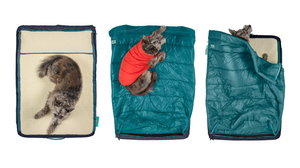2 min read • By Leena Chitnis, Founder, Timberdog
Our furry friends can sometimes develop bed sores, also known as pressure sores or decubitus ulcers, which can be painful and uncomfortable. But worry not, I'll guide you through the steps to help your beloved pets recover and feel better.
Step 1: Gentle Cleaning
The first thing you want to do is gently clean the bed sore using a mild antiseptic solution or saline. It's essential to remove any dirt or debris to prevent infection and promote healing. Avoid using harsh chemicals or hydrogen peroxide, as they can irritate the wound further. You also want to make sure to wash your dog's bed, as the bacteria on it can exacerbate things or delay wound healing.
Step 2: Keep it Dry
Moisture can slow down the healing process, so make sure to keep the affected area dry. But remember, excessive drying can be harmful too, so finding the right balance is crucial.
Step 3: Topical Ointment
After cleaning and drying the wound, apply a vet-recommended topical ointment or wound dressing. These can protect the sore, support healing, and prevent infection. Follow your veterinarian's instructions on how often to apply it.
Step 4: Fresh Bedding
Keep your dog's bed clean and dry by changing the bedding regularly. This helps prevent further irritation and creates a comfortable environment for healing.
Step 5: Use an Elizabethan Collar
If your dog tends to lick or scratch the bed sore, an Elizabethan collar (yes, the ever-dreadful "cone of shame," haha) can be really helpful. It prevents them from reaching the affected area and interfering with the healing process.
Step 6: Regular Check-ups
Keep a close eye on the bed sore's progress. If you notice any signs of infection, increased redness, or swelling, or if the wound isn't getting better, don't hesitate to consult your veterinarian immediately.
Step 7: Healthy Diet
A well-balanced and nutritious diet is essential to support your dog's immune system and promote healing. Speak to your veterinarian for dietary recommendations, especially if the bed sores are related to an underlying health issue.
Step 8: Avoid Pressure
If possible, provide a soft, padded surface for your dog to rest on. This minimizes pressure on the affected area and helps prevent further discomfort.
Step 9: Gentle Exercise
Encourage gentle exercise to improve blood circulation, which aids in the healing process. But be careful not to engage in activities that put direct pressure on the bed sore.
Step 10: Follow Medication Instructions
If your veterinarian prescribes pain relief or antibiotics, follow their instructions carefully and complete the course of medication.
Remember, every dog is unique, and some bed sores may require specialized care. Always seek guidance from your veterinarian for a proper diagnosis and a treatment plan tailored to your dog's specific needs. With your love and proper care, your dog will be on the road to recovery in no time.
Photo credit: Peter Barrot

